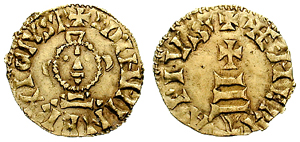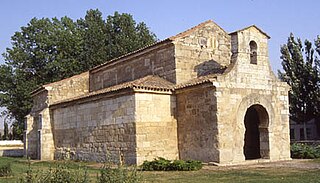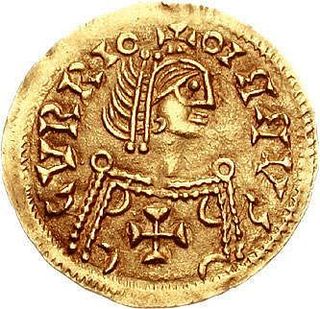Quiricus (Catalan : Quirze), a churchman and well-connected man of letters, was the bishop of Barcelona from 648 until about 667 during the Visigothic period.
Quiricus wrote a hymn in honour of Saint Eulalia. The hymn Barchinon laete Cucufate vernans, in honour of Saint Cucuphas (Cugat), was probably also composed by him. [1] At Quiricus' request, Taio, Bishop of Zaragoza, began compiling an anthology of extracts from the work of Gregory the Great in 653. In 654, progress on the compilation was slowed by the revolt of Froia and the invasion of the Basques. [2] Archbishop Ildefonsus of Toledo dedicated his treatise on the perpetual virginity of Mary (De perpetua virginitate) to Quiricus.
Quiricus of Barcelona may be identical to the Quiricus of Toledo who appears as bishop there from about 670 until his death in 680. [3]

Erwig was a king of the Visigoths in Hispania (680–687).
Achila II was the Visigothic king of Hispania from 710 or 711 until his death. The kingdom he ruled was restricted to the northeast of the old Hispanic kingdom on account of the Arabo-Berber invasions.

Liuvigild, Leuvigild, Leovigild, or Leovigildo, was a Visigothic King of Hispania and Septimania from 569 to 586. Known for his Codex Revisus or Code of Leovigild, a law allowing equal rights between the Visigothic and Hispano-Roman population, his kingdom covered modern Portugal and most of modern Spain down to Toledo. Liuvigild ranks among the greatest Visigothic kings of the Arian period.
Julian of Toledo (642–690) was born in Toledo, Hispania. He was well educated at the cathedral school, was a monk and later abbot at Agali, a spiritual student of Saint Eugene II, and archbishop of Toledo. He was the first bishop to have primacy over the entire Iberian Peninsula—a position he has been accused of securing by being complicit in 680 in the supposed poisoning of Wamba, king of the Visigoths—and he helped centralize the Iberian Church in Toledo. His elevation to the position of primate of the Visigothic church was a source of great unhappiness among the kingdom's clergy. And his views regarding the doctrine of the Trinity proved distressing to the Vatican.
Oppas, also spelled Oppa, was a member of the Visigothic elite in the city of Toledo on the eve of the Muslim conquest of Hispania. He was a son of Egica and therefore a brother or half-brother of Wittiza.

The Visigoths entered Hispania in 415 and they rose to be the dominant people there until the Umayyad conquest of Hispania of 711 brought their kingdom to an end.

Ildefonsus or Ildephonsus was a scholar and theologian who served as the metropolitan Bishop of Toledo for the last decade of his life. His Gothic name was Hildefuns. In the Ethiopian Orthodox Tewahedo Church he is known as Dexius based on the Ge'ez translation of legends about his life.
The Fourteenth Council of Toledo first met in Toledo, Spain, on 14 November 684 under Visigothic King Erwig. It was called in response to a letter from Pope Leo II directing the king, a Count Simplicius, and the recently deceased Quiricus, metropolitan of Toledo, to call a general council to confirm the decisions of the ecumenical Third Council of Constantinople against monothelitism.
Mozarabic chant is the liturgical plainchant repertory of the Visigothic/Mozarabic rite of the Catholic Church, related to the Gregorian chant. It is primarily associated with Hispania under Visigothic rule and later with the Mozarabs and was replaced by the chant of the Roman rite following the Christian Reconquest of the Iberian Peninsula. Although its original medieval form is largely lost, a few chants have survived with readable musical notation, and the chanted rite was later revived in altered form and continues to be used in a few isolated locations in Spain, primarily in Toledo.

Saint Cucuphas is a martyr of Spain. His feast day is 25 July but in some areas it is celebrated on 27 July to avoid conflict with the important feast day of Santiago, the patron saint of Spain. His name is said to be of Phoenician origin with the meaning of "he who jokes, he who likes to joke."
Maximus was the first Visigothic bishop of Zaragoza (Hispania) in 592–619. He was also a theologian and historian.

The Visigothic Kingdom, Visigothic Spain or Kingdom of the Goths occupied what is now southwestern France and the Iberian Peninsula from the 5th to the 8th centuries. One of the Germanic successor states to the Western Roman Empire, it was originally created by the settlement of the Visigoths under King Wallia in the province of Gallia Aquitania in southwest Gaul by the Roman government and then extended by conquest over all of Hispania. The Kingdom maintained independence from the Eastern Roman or Byzantine Empire, whose attempts to re-establish Roman authority in Hispania were only partially successful and short-lived.
Quiricus may refer to:

Masona or Mausona was the Bishop of Mérida and metropolitan of the province of Lusitania from about 570 until his death. He is famous for exercising de facto rule of the city of Mérida during his tenure as bishop and for founding the first confirmed hospital in Spain.

Fidelis was the Bishop of Mérida flourishing probably in the 550s and 560s.
Paul was the metropolitan bishop of Mérida in the mid-sixth century. He was a Greek physician who had travelled to Mérida, where there may have been a Greek expatriate community. Certainly enough Greek clergy were travelling to Spain in the early sixth century that Pope Hormisdas wrote to the Spanish bishops in 518 explaining what to do if Greeks still adhering to the Acacian heresy desired to enter communion with the local church.
Quiricus was the metropolitan bishop of Toledo from about 667 until his death. He may be identical to Bishop Quiricus of Barcelona, who does not appear as bishop there after 667. If so, his transfer to Toledo was contrary to canon law, but would demonstrate the growing importance of Toledo in the Visigothic church.

The Archdiocese of Mérida–Badajoz is a Latin Church ecclesiastical territory of the Catholic Church in Spain, created in 1255. Until 1994, it was known as the Diocese of Badajoz.
Taius was a bishop of Zaragoza during the Visigothic period, from 651-664, succeeding his teacher Saint Braulius. His surname was Samuel (Samuhel). Taius, like Braulius and Bishop Ildefonsus, was also a pupil of Saint Isidore of Seville.

Toledo is the repository of more than 2000 years of history. Successively a Roman municipium, the capital of the Visigothic Kingdom, a fortress of the Emirate of Cordoba, an outpost of the Christian Kingdom, and in the 16th century, the temporary seat of supreme power under Charles V. Its many works of art and architecture are the product of three major religions – Judaism, Christianity and Islam.